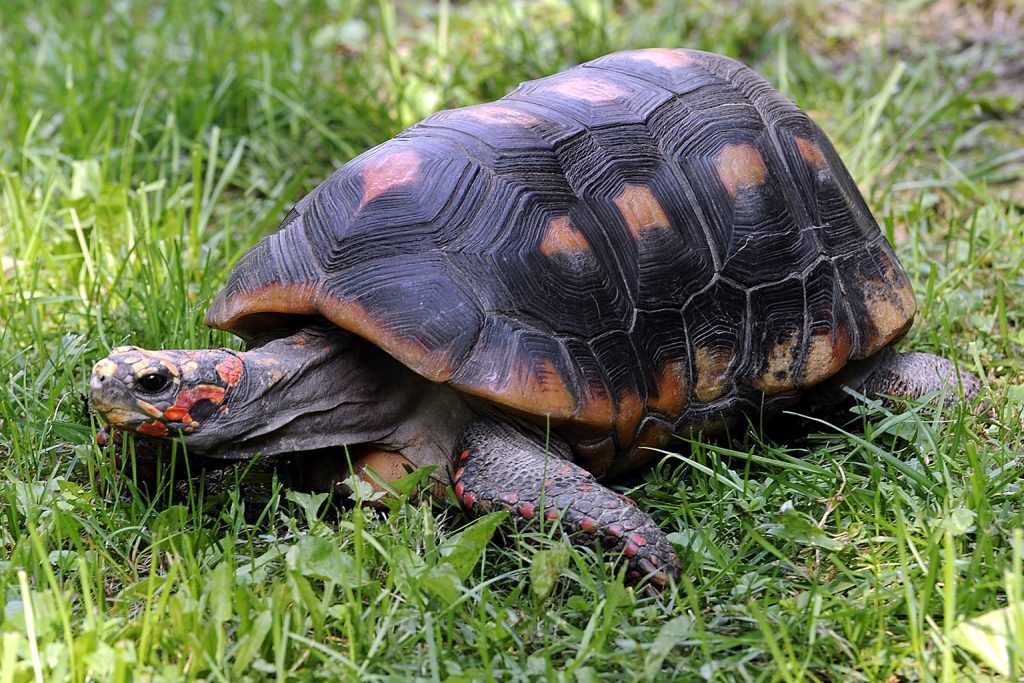
One of the most striking features of the full grown red foot tortoise is its size. These tortoises can reach an impressive foot in length and can weigh between 10-20 pounds. Their large size not only makes them an impressive addition to any collection, but also means they require plenty of space to roam and explore.
Size of Full Grown Red Foot Tortoises
On average, full grown red foot tortoises can reach a size of 12 to 16 inches in shell length. However, some individuals have been known to grow even larger, measuring up to 18 inches in shell length.
Their weight can vary depending on factors such as age, sex, and overall health, but typically, full grown red foot tortoises weigh between 15 to 30 pounds. Females tend to be slightly larger and heavier than males.
It’s worth noting that these tortoises grow slowly over time, and it can take them several years to reach their full size. Therefore, if you are considering getting a red foot tortoise as a pet, be prepared to provide long-term care for these magnificent creatures.
Factors Affecting Size
Several factors can influence the size of full grown red foot tortoises. Genetics play a significant role as some individuals may have the potential to grow larger than others due to their genetic makeup.
Nutrition is also a crucial aspect of determining the size of these tortoises. A well-balanced diet with proper amounts of calcium, vitamins, minerals, and other essential nutrients contributes to their growth and overall size.
Size Comparison

When comparing the size of full grown red foot tortoises to other species, they are considered to be medium to large-sized tortoises. However, they are smaller in size when compared to some other popular tortoise species like the African spurred tortoise or the Galapagos tortoise.
Caring for Full Grown Red Foot Tortoises
1. Enclosure: Provide a spacious enclosure for your full grown red foot tortoise to roam and explore. A large outdoor enclosure or a tortoise table with ample space is ideal. Make sure the enclosure is secure to prevent any escapes.
2. Temperature and Humidity: Red foot tortoises thrive in warm and humid environments. Maintain a temperature range of 75-85 degrees Fahrenheit (24-29 degrees Celsius) during the day, with a slight drop at night. The humidity level should be around 60-80%. Use a thermometer and hygrometer to monitor these conditions.
3. Substrate: Use a substrate that mimics the natural environment of red foot tortoises, such as a mixture of soil, coconut coir, and cypress mulch. This substrate retains moisture and allows the tortoise to burrow. Avoid substrates that are toxic or can cause impaction.
4. Lighting and UVB: Full spectrum UVB lighting is essential for red foot tortoises to metabolize calcium and stay healthy. Provide a UVB lamp along with a heat lamp to create a basking spot with temperatures around 90 degrees Fahrenheit (32 degrees Celsius).
5. Feeding: Red foot tortoises have a varied omnivorous diet. Offer a mix of leafy greens, vegetables, fruits, and occasional animal protein such as cooked eggs or worms. Calcium and vitamin supplements should be provided regularly to ensure proper nutrition.
6. Water: Provide a shallow water dish for drinking and soaking. The water should be changed daily and the dish should be large enough for the tortoise to comfortably enter and exit.
7. Veterinary Care: Regular check-ups with a reptile veterinarian are important to monitor the overall health of your red foot tortoise. These check-ups can help detect any potential health issues and ensure proper care and treatment if necessary.
Remember, caring for a full grown red foot tortoise requires commitment and attention to detail. By providing the proper enclosure, temperature, humidity, substrate, lighting, diet, and veterinary care, you can ensure a happy and healthy life for your red foot tortoise.
Nutrition and Diet for Full Grown Red Foot Tortoises

In addition to leafy greens, full grown red foot tortoises can also benefit from other vegetables like carrots, squash, and bell peppers. These vegetables provide additional vitamins and minerals, as well as added moisture to their diet.
It’s crucial to avoid feeding red foot tortoises foods that are toxic to them. Some common foods to avoid include onions, garlic, avocados, and rhubarb. These foods can be harmful and even fatal to tortoises if ingested.
| Vegetable | Frequency | Portion size |
|---|---|---|
| Kale | 3 times a week | A handful |
| Collard Greens | 3 times a week | A handful |
| Dandelion Greens | 3 times a week | A handful |
| Carrots | once a week | A small piece |
| Squash | once a week | A small piece |
| Bell Peppers | once a week | A small piece |
In addition to a varied diet of vegetables, full grown red foot tortoises can also benefit from occasional insect protein. This can include mealworms, crickets, and snails. However, insects should only make up a small portion of their diet and should be offered sparingly.
Overall, a balanced diet consisting of a variety of leafy greens, vegetables, and occasional insects will help keep full grown red foot tortoises healthy and thriving.
Behavior and Habitat of Full Grown Red Foot Tortoises
Full grown red foot tortoises are also known for their social nature. They are often found in small groups or pairs, and they engage in various social interactions. They communicate with each other through a combination of vocalizations, body movements, and scent marking.
In terms of their habitat, full grown red foot tortoises require a spacious and well-vegetated enclosure. This is because they are primarily herbivorous and need plenty of plants to graze on. The enclosure should also include hiding spots, such as logs or plants, where the tortoises can retreat to when they want to feel secure.
